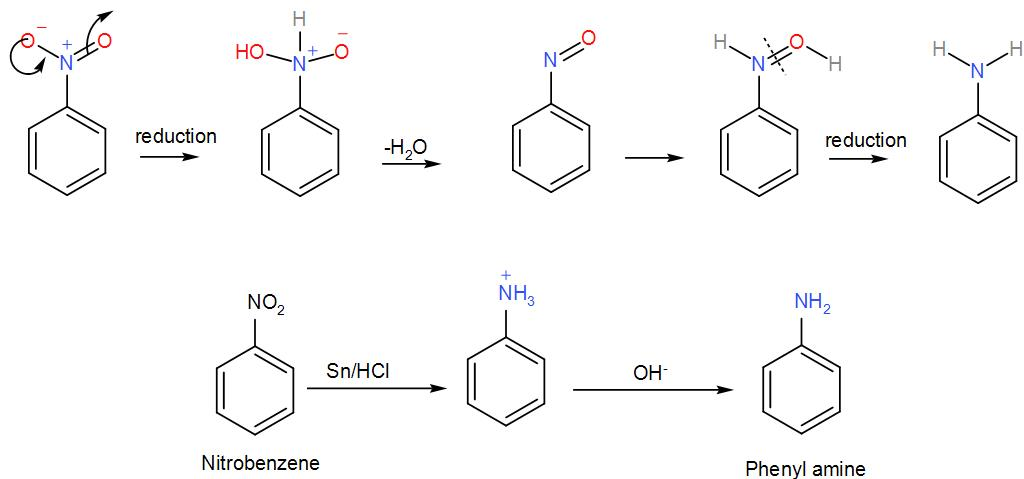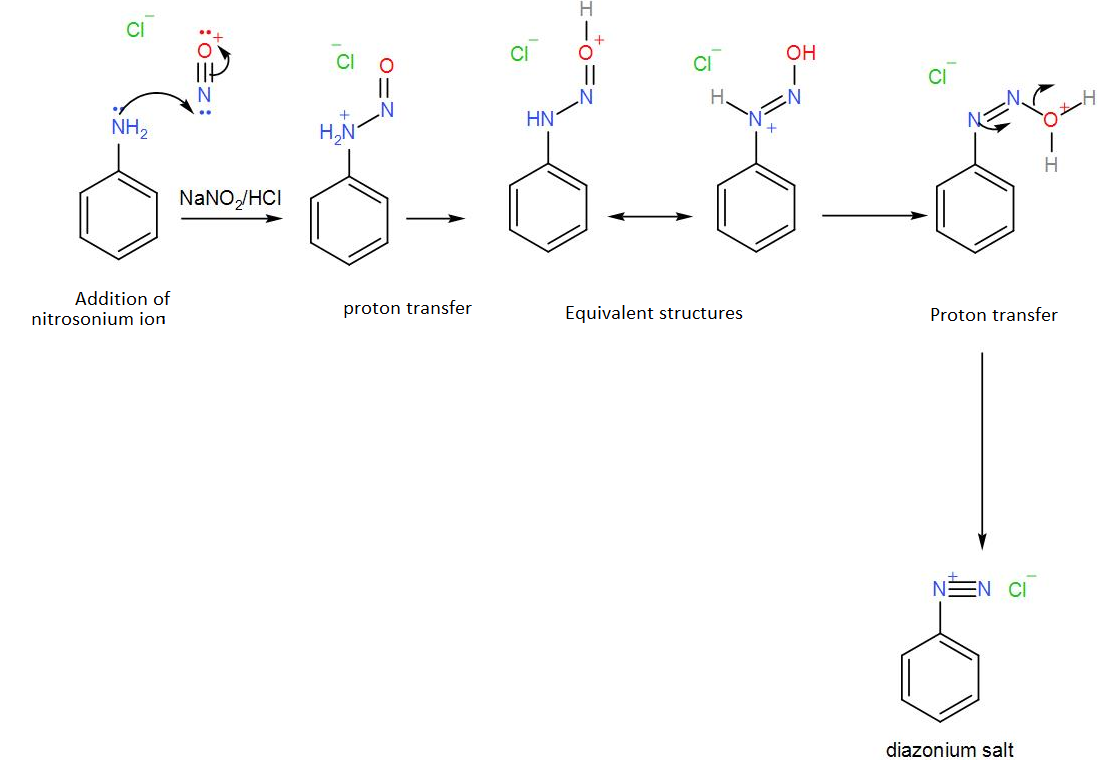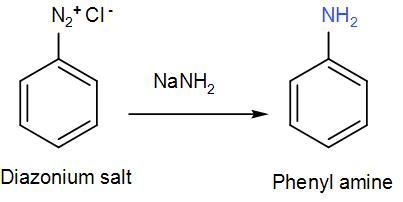Answer
36.9k+ views
Hint: To solve this, proceed step wise and identify A, B and then arrive at C. Remember that tin with hydrochloric acid will reduce nitrobenzene and will give you an amine. Upon reaction with sodium nitride the amine will give you a salt. The salt will react with sodium amide and again arrive at phenyl amine.
Complete step by step solution:
To solve this, let’s see the reaction of nitrobenzene with the given reagents and then arrive at the final result.
In the first step, nitrobenzene reacts with tin and hydrochloric acid. It is a redox reaction and here the nitrobenzene is reduced to phenylamine. The reaction proceeds via formation of a phenyl ammonium cation by reduction of nitrobenzene. We can write the reaction as-

So, phenylamine is ‘A’. To this, sodium nitrite is added which will cause the amine to undergo diazotization. The hydrochloric acid in the reaction will react with it thus leading to the formation of a diazonium salt of benzene called benzene diazonium chloride. We can write the reaction as-

The diazonium salt thus obtained is our ‘B’.
To this diazonium salt when we add sodium amide we will again get the phenyl amine. We can write the reaction as-

The phenyl amine is ‘C’. It is also known as aniline.
We can see from the above discussion that the ‘C’ in the reaction series is aniline.
Therefore, the correct answer is option [D] Aniline.
Note: Primary amines give us a diazonium salt which forms alcohols in addition to water but secondary amines have one hydrogen atom attached to them therefore, they cannot complete the diazotization reaction and give us a yellow oily nitrosamine product. Three degree amines have no hydrogen atoms attached to them thus they undergo simple acid- base reactions and give us soluble salts.
Complete step by step solution:
To solve this, let’s see the reaction of nitrobenzene with the given reagents and then arrive at the final result.
In the first step, nitrobenzene reacts with tin and hydrochloric acid. It is a redox reaction and here the nitrobenzene is reduced to phenylamine. The reaction proceeds via formation of a phenyl ammonium cation by reduction of nitrobenzene. We can write the reaction as-

So, phenylamine is ‘A’. To this, sodium nitrite is added which will cause the amine to undergo diazotization. The hydrochloric acid in the reaction will react with it thus leading to the formation of a diazonium salt of benzene called benzene diazonium chloride. We can write the reaction as-

The diazonium salt thus obtained is our ‘B’.
To this diazonium salt when we add sodium amide we will again get the phenyl amine. We can write the reaction as-

The phenyl amine is ‘C’. It is also known as aniline.
We can see from the above discussion that the ‘C’ in the reaction series is aniline.
Therefore, the correct answer is option [D] Aniline.
Note: Primary amines give us a diazonium salt which forms alcohols in addition to water but secondary amines have one hydrogen atom attached to them therefore, they cannot complete the diazotization reaction and give us a yellow oily nitrosamine product. Three degree amines have no hydrogen atoms attached to them thus they undergo simple acid- base reactions and give us soluble salts.
Recently Updated Pages
If a wire of resistance R is stretched to double of class 12 physics JEE_Main

The path difference between two waves for constructive class 11 physics JEE_MAIN

What is the difference between solvation and hydra class 11 chemistry JEE_Main

IfFxdfrac1x2intlimits4xleft 4t22Ft rightdt then F4-class-12-maths-JEE_Main

Sodium chloride is purified by passing hydrogen chloride class 11 chemistry JEE_Main

Consider the following oxyanions PO43P2O62SO42MnO4CrO4S2O52S2O72 class 11 chemistry JEE_Main

Other Pages
The mole fraction of the solute in a 1 molal aqueous class 11 chemistry JEE_Main

If a wire of resistance R is stretched to double of class 12 physics JEE_Main

Lowering in vapour pressure is highest for A 02 m urea class 11 chemistry JEE_Main

An electric bulb has a power of 500W Express it in class 11 physics JEE_Main

Which of the following Compounds does not exhibit tautomerism class 11 chemistry JEE_Main

The ratio of speed of sound in Hydrogen to that in class 11 physics JEE_MAIN




